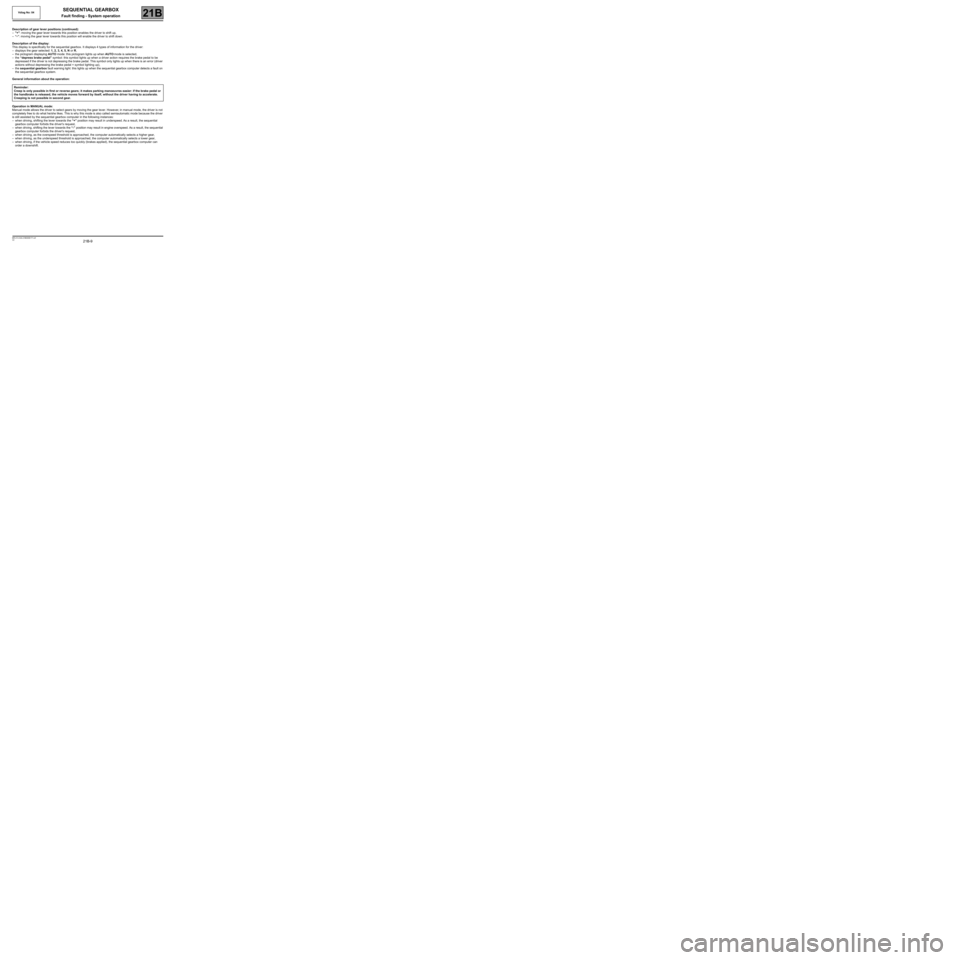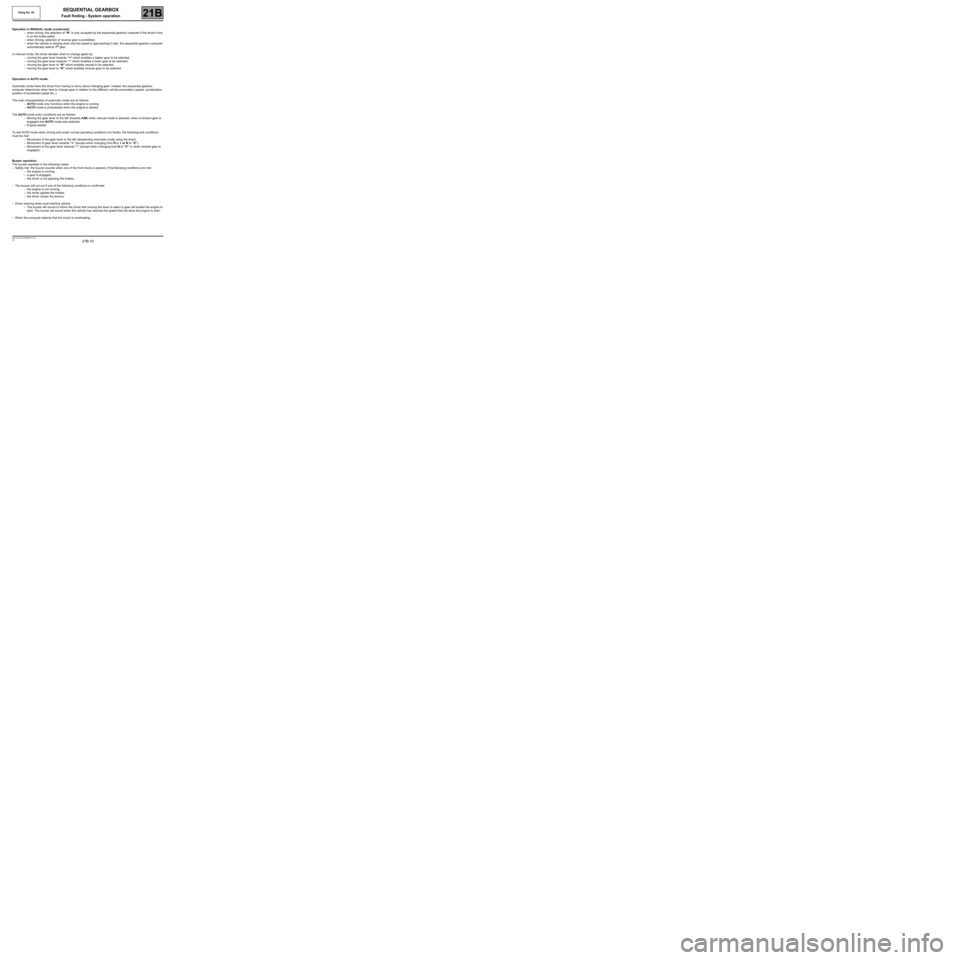brakes RENAULT TWINGO 2009 2.G Sequential Transmission Workshop Manual
[x] Cancel search | Manufacturer: RENAULT, Model Year: 2009, Model line: TWINGO, Model: RENAULT TWINGO 2009 2.GPages: 138
Page 9 of 138

21B-9
MR-413-X44-21B000$177.mif
V2
Vdiag No: 04SEQUENTIAL GEARBOX
Fault finding - System operation21B
Description of gear lever positions (continued):
–"+": moving the gear lever towards this position enables the driver to shift up,
–“-”: moving the gear lever towards this position will enable the driver to shift down.
Description of the display:
This display is specifically for the sequential gearbox. It displays 4 types of information for the driver:
–displays the gear selected: 1, 2, 3, 4, 5, N or R,
–the pictogram displaying AUTO mode: this pictogram lights up when AUTO mode is selected,
–the “depress brake pedal” symbol: this symbol lights up when a driver action requires the brake pedal to be
depressed if the driver is not depressing the brake pedal. This symbol only lights up when there is an error (driver
actions without depressing the brake pedal = symbol lighting up),
–the sequential gearbox fault warning light: this lights up when the sequential gearbox computer detects a fault on
the sequential gearbox system.
General information about the operation:
Operation in MANUAL mode:
Manual mode allows the driver to select gears by moving the gear lever. However, in manual mode, the driver is not
completely free to do what he/she likes. This is why this mode is also called semiautomatic mode because the driver
is still assisted by the sequential gearbox computer in the following instances:
–when driving, shifting the lever towards the “+” position may result in underspeed. As a result, the sequential
gearbox computer forbids the driver's request,
–when driving, shifting the lever towards the “-” position may result in engine overspeed. As a result, the sequential
gearbox computer forbids the driver's request,
–when driving, as the overspeed threshold is approached, the computer automatically selects a higher gear,
–when driving, as the underspeed threshold is approached, the computer automatically selects a lower gear,
–when driving, if the vehicle speed reduces too quickly (brakes applied), the sequential gearbox computer can
order a downshift. Reminder:
Creep is only possible in first or reverse gears; it makes parking manoeuvres easier: if the brake pedal or
the handbrake is released, the vehicle moves forward by itself, without the driver having to accelerate.
Creeping is not possible in second gear.
Page 10 of 138

21B-10
MR-413-X44-21B000$177.mif
V2
Vdiag No: 04SEQUENTIAL GEARBOX
Fault finding - System operation21B
Operation in MANUAL mode (continued):
–when driving, the selection of “N” is only accepted by the sequential gearbox computer if the driver's foot
is on the brake pedal,
–when driving, selection of reverse gear is prohibited,
–when the vehicle is slowing down and the speed is approaching 0 mph, the sequential gearbox computer
automatically selects 1
st gear.
In manual mode, the driver decides when to change gears by:
–moving the gear lever towards “+” which enables a higher gear to be selected,
–moving the gear lever towards “-” which enables a lower gear to be selected,
–moving the gear lever to “N” which enables neutral to be selected,
–moving the gear lever to “R” which enables reverse gear to be selected.
Operation in AUTO mode:
Automatic mode frees the driver from having to worry about changing gear: instead, the sequential gearbox
computer determines when best to change gear in relation to the different vehicle parameters (speed, acceleration,
position of accelerator pedal etc.,).
The main characteristics of automatic mode are as follows:
–AUTO mode only functions when the engine is running.
–AUTO mode is preselected when the engine is started.
The AUTO mode entry conditions are as follows:
–Moving the gear lever to the left (towards A/M) when manual mode is selected, when a forward gear is
engaged and AUTO mode was selected.
–Engine started.
To exit AUTO mode when driving and under normal operating conditions (no faults), the following exit conditions
must be met:
–Movement of the gear lever to the left (deselecting automatic mode using the lever).
–Movement of gear lever towards “+” (except when changing from R to 1 or N to “X”).
–Movement of the gear lever towards “-” (except when changing from N to “X” or when reverse gear is
engaged).
Buzzer operation:
The buzzer operates in the following cases:
–Safety risk: the buzzer sounds when one of the front doors is opened, if the following conditions are met:
–the engine is running,
–a gear is engaged,
–the driver is not applying the brakes.
–The buzzer will cut out if one of the following conditions is confirmed:
–the engine is not running,
–the driver applies the brakes,
–the driver closes the door(s).
–Driver warning when push-starting vehicle:
–The buzzer will sound to inform the driver that moving the lever to select a gear will enable the engine to
start. The buzzer will sound when the vehicle has reached the speed that will allow the engine to start.
–When the computer detects that the clutch is overheating.